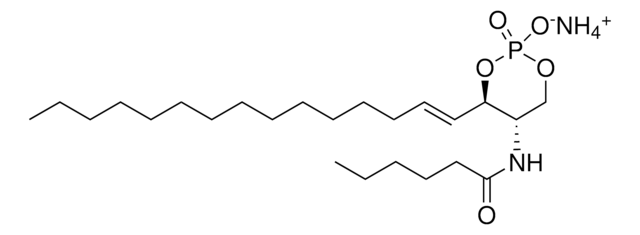860831P
Avanti
C6(6-azido) Ceramide
Avanti Research™ - A Croda Brand 860831P, powder
Synonym(s):
N-(6-azidohexanoyl)-D-erythro-sphingosine
Sign Into View Organizational & Contract Pricing
All Photos(1)
About This Item
Empirical Formula (Hill Notation):
C24H46 N4O3
CAS Number:
Molecular Weight:
438.65
UNSPSC Code:
12352211
NACRES:
NA.25
Recommended Products
form
powder
packaging
pkg of 1 × 5 mg (860831P-5mg)
manufacturer/tradename
Avanti Research™ - A Croda Brand 860831P
lipid type
click reagents
shipped in
dry ice
storage temp.
−20°C
SMILES string
OC[C@]([H])(NC(CCCCCN=[N+]=[N-])=O)[C@]([H])(O)/C=C/CCCCCCCCCCCCC
General description
C6(6-azido) Ceramide, also known as N-(6-azidohexanoyl)-D-erythro-sphingosine, is a head group modified lipid. This click reagent contains an azide group in the omega-terminal end, which can be used in a copper-catalyzed azide−alkyne click chemistry. Copper-catalyzed azide−alkyne cycloaddition reaction facilitates the connection of molecular entities of all sizes.
This reagent is a modified lipid containing an omega-terminal azide. The terminal azide group can be used in a highly specific linking reaction with alkyne-containing reagents, known as click chemistry, in the presence of a copper (Cu)-containing catalyst.
Packaging
5 mL Amber Glass Screw Cap Vial (860831P-5mg)
Legal Information
Avanti Research is a trademark of Avanti Polar Lipids, LLC
Storage Class Code
11 - Combustible Solids
WGK
WGK 3
Flash Point(F)
No data available
Flash Point(C)
No data available
Certificates of Analysis (COA)
Search for Certificates of Analysis (COA) by entering the products Lot/Batch Number. Lot and Batch Numbers can be found on a product’s label following the words ‘Lot’ or ‘Batch’.
Already Own This Product?
Find documentation for the products that you have recently purchased in the Document Library.
Stanislav I Presolski et al.
Current protocols in chemical biology, 3(4), 153-162 (2011-01-01)
The copper-catalyzed azide-alkyne cycloaddition reaction is widely used for the connection of molecular entities of all sizes. A protocol is provided here for the process with biomolecules. Ascorbate is used as reducing agent to maintain the required cuprous oxidation state.
Our team of scientists has experience in all areas of research including Life Science, Material Science, Chemical Synthesis, Chromatography, Analytical and many others.
Contact Technical Service








